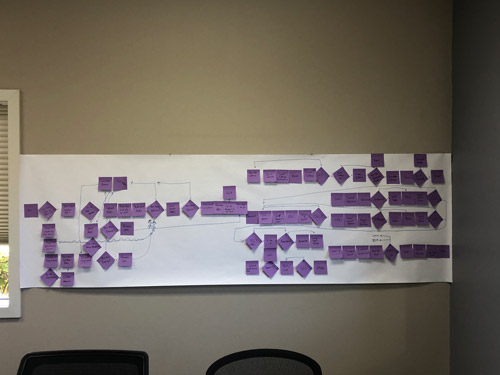The virtues of writing something down cannot be overstated. Especially given we’re all feeling the pressure from an industry with ongoing labor shortages, large-scale projects, stronger than-ever demand for more sustainable building practices and technologies, and far-flung job sites. Just one day spent designing a thorough enough plan could save several days of repeating steps and wasted time. That’s why we recommend process mapping as a best practice for your prefabrication and modularization strategies. It’s simple, elegant and can reduce headaches across shareholders while boosting productivity and driving results — provided it’s recorded.
While it wouldn’t be fair to say that, as an industry, we don’t meticulously plan; it is probably fair to say that lifelong professionals don’t often commit their tips, tricks, and trade secrets to paper (or digital). That means when experts leave (for the next job, the next company, or retirement), they take their information with them. Teams left behind lose that knowledge, processes suffer, timelines extend, and the work gets gummed up until someone figures out what was missing and gets everything back on track. Unfortunately, that usually means that now another person has an entire process built into their brain, so the cycle will lather, rinse, and repeat in perpetuity unless someone gets things written down.
That said, writing out a process is about more than saving it for posterity. Process mapping makes essential information accessible to quickly share with travelers and during turnover so new boots can hit the ground and run (which is arguably a universal demand in our business). They invite a meeting of minds early on in the planning phases so that processes can be improved upon and enhanced, not simply repeated as usual. It encourages the development of a common language among stakeholders, gets extra eyes on the entire project from the beginning, provides clarity, and encourages accountability, all of which set the tone for a better build.

Figure 1. (Courtesy of Harris)
As an example, we’re providing a process map developed for one of our projects, which was started on paper (Fig. 1) during a live discussion. This piece probably took about a business day to complete and transfer into a clean, digital version (Fig. 2). Here’s how things break down on this chart:
Shapes are used to identify the type of process required. Squares and rectangles are steps and activities, where diamonds either signify a question that needs to be answered before moving on or a place for necessary quality control checks.
Swim lanes break the project out by actor and show how the flow of the work travels between teams. They help identify what information needs to be passed by Team X to Team Y, as well as indicate who needs to be involved or looped back in.

Figure 2. (Courtesy of Harris)
We also decided to highlight “value add” activities (meaning actions where our prefabrication work is literally being performed) in green to differentiate them from activities that require completion but aren’t literally prefab work (blue). For example, cutting fittings (green), sorting through them (blue), putting beads on/stiffening and forming (green), quality checking (blue), and then lining (green).
With technological advances changing the way we work, it’s also important to create a culture of collaboration without adding strain to a workforce that is already stretched thin. Process mapping gets that ball rolling by design; it’s effectively a team-building exercise without the buzzwords. Because so many of the innovative new solutions driving our industry today rely on clear communication between those in the field and those in the office, thorough process maps become an essential way to break down silos and get professionals on the same page quickly.
Finally, you can customize your process maps to flag any and all elements essential to the forward motion of your project. Whether you’re looking to flag risks (to manage them better), track value streams, monitor scope and boundaries, or to just stay on top of the basics and keep documentation quickly on hand for personnel, process mapping is, if not the answer, then certainly a step in the right direction.



Report Abusive Comment